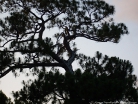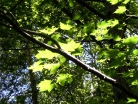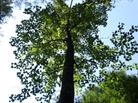
Home>Browse by State>Native Trees of Colorado

-Color denotes a tree that is rare or endangered

Want to add your tree to our picture gallery? Click here for details!
State Tree: Colorado Blue Spruce

Colorado
The Centenneial State, 'Nothing without Providence'



™

Sunday, June 08, 2025
™

Custom Search
We are part of the Hubpages community.
Click here for more info.
Click here for more info.





Picturing the landscape of Colorado
conjures images of the Rocky Mountains, high forests
of spruce and fir trees, snow capped mountain peaks,
raging rivers, and cold clear waters. The large
amount of preserved wilderness, particularly in
western Colorado, offers many quiet destinations for
a weekend, or week long, getaway. Under the big
blue sky of Colorado, the nature lover can enjoy a
cornucopia of activities. White water rafting at the
Arkansas Headwater, rock climbing at El Dorado
Canyon, skiing, ice fishing in winter, or less
Native Trees of Colorado

strenuous activities such as watching for bald eagles, sailing, or hoping to hook the big one
at Spinny Mountain or Eleven Mile Reservoirs draw thousands of tourists every year.
Colorado should be on every outdoor enthusiast's list of top places to visit. There are
many unique gems found within its borders such as the Great Sand Dunes National Park,
where you can see the tallest dunes in North America towering 750 feet and in the northeast
corner of Crescent Meadows, you can walk through a rare forest of Douglas-fir and river
birch. If animals are more your interest, North Park bills itself as Colorado’s moose viewing
capital with a year round population of 600. In the winter, countless birds migrate to or
through Colorado, with some areas seeing as many as 350 different migrant or resident
species. Barr Lake, in Brighton, is a winter refuge for countless bald eagles and is said to
have over 200 nests. There are also millions of acres of land to explore within the
spectacular Rocky Mountains National Park or the Rio Grande National Forest, home of the
mighty Rio Grande River's headwaters. No matter what time of year, Colorado has no end
to its natural beauty. If you want to escape into high altitude verdant forests or prairies, ski
down pristine mountain slopes, or find adventures in between, Colorado is a must see.
Picea pungens, cones ©1995 Br. Alfred Brousseau See usage requirements.
The Colorado Blue Spruce,
Picea pungens, was designated the state
tree on March 7, 1939 for it's iconic and
stately form and silvery-blue needles.

Colorado Tree Facts

Forested acres: 24.4 million
Percent of land forested: 36%
Predominant forest type: Spruce-Fir
Number of State Parks: 44
Number of National Forests: 13
Number of Tree city USA communities: 92
Number of invasive trees/shrubs: 17 (see state list for noxious/invasive plants)
Damaging insects of high concern: Mountain Pine Beetle
Number of tree families in our collection: 15
Number of endangered or threatened species in our collection: 0
References:
Colorado State University-Colorado State Forest Service
Colorado.gov
National Park Service, http://www.fs.usda.gov/
EDDMapS. 2013. Early Detection & Distribution Mapping System. The University of Georgia - Center for Invasive Species and Ecosystem Health. Available online at http://www.eddmaps.org/; last accessed January 17, 2013.
Additional state resources:
Colorado Department of Personnel & Administrations
Colorado State Parks and Wildlife
USDA Forest Service, National Parks
Percent of land forested: 36%
Predominant forest type: Spruce-Fir
Number of State Parks: 44
Number of National Forests: 13
Number of Tree city USA communities: 92
Number of invasive trees/shrubs: 17 (see state list for noxious/invasive plants)
Damaging insects of high concern: Mountain Pine Beetle
Number of tree families in our collection: 15
Number of endangered or threatened species in our collection: 0
References:
Colorado State University-Colorado State Forest Service
Colorado.gov
National Park Service, http://www.fs.usda.gov/
EDDMapS. 2013. Early Detection & Distribution Mapping System. The University of Georgia - Center for Invasive Species and Ecosystem Health. Available online at http://www.eddmaps.org/; last accessed January 17, 2013.
Additional state resources:
Colorado Department of Personnel & Administrations
Colorado State Parks and Wildlife
USDA Forest Service, National Parks
Follow the links to view species native to Colorado. If the genus is not linked, species are listed on the family page.
Aceraceae, Maple
Betulaceae, Birch
Alnus, Alder
Betula, Birch
Bignoniaceae, Trumpet Creeper
Catalpa, Catalpa
Chilopsis, Desert Willow
Caprifoliaceae, Honeysuckle
Sambucus, Elderberry
Viburnum, Viburnum
Cupressaceae- Cypress
Juniperus, Juniper
Aceraceae, Maple
Betulaceae, Birch
Alnus, Alder
Betula, Birch
Bignoniaceae, Trumpet Creeper
Catalpa, Catalpa
Chilopsis, Desert Willow
Caprifoliaceae, Honeysuckle
Sambucus, Elderberry
Viburnum, Viburnum
Cupressaceae- Cypress
Juniperus, Juniper
Colorado Tree Families and Genera

click to enlarge.
Useful information while browsing species:
• How to read a botanical name
• How to use our species boxes:
• How to read a botanical name
• How to use our species boxes:
-Color denotes a tree that is rare or endangered

Please note: This is not a complete list of all native tree families and species found in Colorado. We are constantly working towards a more comprehensive list and will add families and their species as completed.
Additional Resources:
North American Native Tree Families
North American A to Z List by Scientific Name
North American A to Z List by Common Name
North American Native Tree Families
North American A to Z List by Scientific Name
North American A to Z List by Common Name
Fabaceae, Pea
Fagaceae, Beech
Quercus, Oak
Juglandaceae, Walnut
Juglans, Walnut
Moraceae, Mulberry
Morus, Mulberry
Oleaceae, Olive Family
Fraxinus, Ash
Pinaceae, Pine
Abies, Fir
Pinus, Pine
Pseudotsuga, Douglas-fir
Fagaceae, Beech
Quercus, Oak
Juglandaceae, Walnut
Juglans, Walnut
Moraceae, Mulberry
Morus, Mulberry
Oleaceae, Olive Family
Fraxinus, Ash
Pinaceae, Pine
Abies, Fir
Pinus, Pine
Pseudotsuga, Douglas-fir
Rosaceae, Rose
Crataegus, Hawthorn
Malus, Crab-apple
Prunus, Plum/Cherry
Rutaceae, Rue
Salicaceae, Willow
Populus, Cottonwood
Salix, Willow
Sapindaceae, Soapberry
Ulmaceae, Elm
Celtis, Hackberry
Ulmus, Elm
Crataegus, Hawthorn
Malus, Crab-apple
Prunus, Plum/Cherry
Rutaceae, Rue
Salicaceae, Willow
Populus, Cottonwood
Salix, Willow
Sapindaceae, Soapberry
Ulmaceae, Elm
Celtis, Hackberry
Ulmus, Elm
Colorado Endangered or Threatened Tree Species

This is not a comprehensive list but we are always working on adding more and will update accordingly.
There are no threatened or endangered Colorado native tree species.
There are no threatened or endangered Colorado native tree species.
Looking for a nursery near you?
Check out our nursery listing by county below!
Sorry, we do not currently have any tree nursery listings for this state. We do update these lists, so please check back.
Check out our nursery listing by county below!
Sorry, we do not currently have any tree nursery listings for this state. We do update these lists, so please check back.


Tree lists:
•A-Z by scientific
name
•A-Z by common
name
•By Family
For state A-Z list click state name below.
•A-Z by scientific
name
•A-Z by common
name
•By Family
For state A-Z list click state name below.

This should come as no surprise as it is probably familiar to most as a
highly sought after Christmas tree. While the beauty of this native
species is well known, it is lesser known that the popularity of Blue
Spruce has given rise to more than 38 horticulture varieties.
Picea pungens typically grows at mid elevations in Colorado, between
6,000 feet in the north and up to 11,000 feet in the southern part of its
range. Blue spruce is a long lived tree with some individual trees
estimated to be near 600 years old. Even the tallest blue spruce usually
doesn't exceed 100 feet tall, but the champion, which just happens to be
The wood of Colorado blue spruce, is lightweight, resinous, and soft. Because of
those properties, and its tendency to grow only in small groves, is not valued
commercially as a timber species. It is however, valued as an ornamental tree and
is often planted in places of prominence in parks or in front of state buildings, and
makes a good landscaping tree for residential use. Despite the shallow root
systems, blue spruce are surprisingly wind firm and are often used as windbreaks.
An ideal habitat for Picea pungens is slightly humid, like near steams, with cool
summers and between 20 to 45 inches of annual rainfall. Learn More

in Colorado, is 126
feet tall. The trunks
are typically 1 to 2
feet in diameter.
Colorado distribution map, courtesy USDA PLANTS Database
|
|
|
|
|
| A-Z scientific | ||
| A-Z by Common Name | ||
| Families | ||
| Browse by State | ||
| Rare or Endangered Species | ||
| Trees_with_Special_Uses | ||
| Tallest and Biggest |
| Aceraceae Maple Family | ||
| Anacardiaceae Sumac Family | ||
| Annonaceae Custard Apple Family | ||
| Aquifoliaceae Holly Family | ||
| Arecaceae, Palm Family | ||
| Betulaceae Birch family | ||
| Bignoniaceae Trumpet Creeper Family | ||
| Burseraceae Frankincense Family | ||
| Caprifoliaceae Honeysuckle Family | ||
| Chrysobalanaceae Coco-plum Family | ||
| Cornaceae Dogwood Family | ||
| Cupressaceae Cypress Family | ||
| Cyrillaceae Cyrilla Family | ||
| Ebenaceae Ebony Family | ||
| Ericaceae Heath Family | ||
| Fabaceae Pea Family | ||
| Fagaceae Beech Family | ||
| Hamamelidaceae Witch Hazel Ffamily | ||
| Hippocastanaceae Horse Chestnut Family | ||
| Juglandaceae Walnut Family | ||
| Lauraceae Laurel Family | ||
| Leitneriaceae Corkwood Family | ||
| Magnoliaceae Magnolia Family | ||
| Meliaceae Mahogany Family | ||
| Moraceae Mulberry Family | ||
| Myricaceae Bayberry Family | ||
| Myrsinaceae Myrsine Family | ||
| Myrtaceae Myrtle Family | ||
| Nyctaginaceae Four Oclock Family | ||
| Olacaceae Olax Family | ||
| Oleaceae Olive Family | ||
| Pinaceae Pine Family | ||
| Platanaceae Plane Tree Family | ||
| Polygonaceae Buckwheat Family | ||
| Rhamnaceae Buckthorn Family | ||
| Rosaceae Rose Family | ||
| Rubiaceae Madder Family | ||
| Rutaceae Rue Family | ||
| Salicaceae Willow Family | ||
| Sapindaceae Soapberry Family | ||
| Sapotaceae Sapodilla Family | ||
| Simaroubaceae Quassia Family | ||
| Styracaceae Storax Family | ||
| Symplocaceae Sweetleaf Family | ||
| Theaceae Tea Family | ||
| Tiliaceae Lindon Family | ||
| Ulmaceae Elm Family | ||
| Taxaceae Yew Family | ||
| Yucca Family |
| Maple A-Z |
| sumac_family_a-z |
| custard_apple_family_a-z |
| holly_trees_a-z |
| palm_family_a-z |
| birch_family_a-z |
| trumpet_creeper_family_a-z |
| honeysuckle_family_a-z |
| dogwood_family_a-z |
| cypress_family_a-z |
| heath_family_a-z |
| pea_family_a-z |
| beech_family_a-z |
| walnut_family_a-z |
| magnolia_family_a-z |
| olive_family_a-z |
| rose_family_a-z |
| willow_family_a-z |
| franklinia |
| elm_family_a-z |
| Federal List | ||
| State Lists | ||
| Invasive_species |
| Restoration of the American Chestnut | ||
| Restoration of the American Elm | ||
| Sustainable Forestry |
| Contact Us | ||
| Our Contributors | ||
| Photo of the Month | ||
| Usage Requirements | ||
| FAQ | ||
| Report a Broken Link |
| photo_submission |
| Photo Store |





